Monday, 18 July 2016, Megève to Annecy
Written 23 August 2016
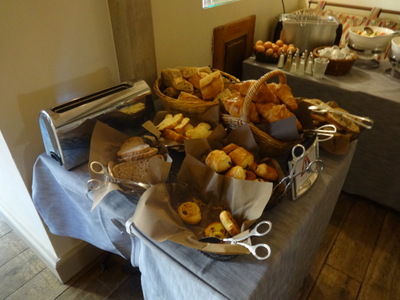
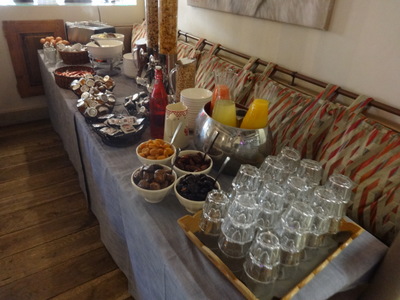 Breakfast at Coeur de Megève was pretty good (as well it might have been, given what the place charges). At the left here is the assortment of breads and pastries, and behind that are the egg boiler, basket of eggs, and collection fo salt and pepper shakers.
Breakfast at Coeur de Megève was pretty good (as well it might have been, given what the place charges). At the left here is the assortment of breads and pastries, and behind that are the egg boiler, basket of eggs, and collection fo salt and pepper shakers.
At the right, three kinds of juice on ice and a wide variety of jams, jellies, honey, and Nutella. In the back, next to the egg boiler, were a big bowl of yogurt and one of chopped fresh fruit. On a different table, with the coffee maker, were cold cuts, sliced local cheeses, and single-serve fruit yogurts.
After breakfast, we walked down to the nearby post office, where I was dismayed to learn that the wonderful prestamped, good forever, 20-g-to anywhere-in-the-world envelopes, in which I have been sending my French vacation postcards for decades now, have been discontinued! Rats. Fortunately, they have been replaced with forever stamps that will turn any envelope into the same thing (but you have to supply your own envelopes; gotta add those to my European packing list).
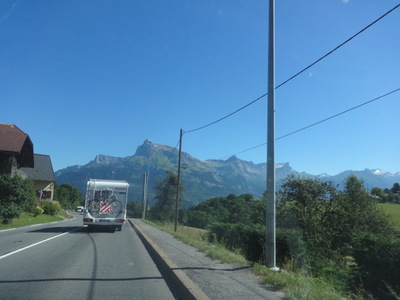
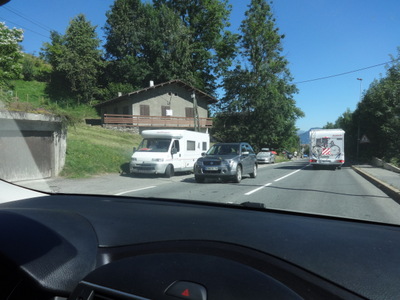 The drive back down the mountain to the freeway was still picturesque, in that the forests and mountains still formed a beautiful backdrop, but preparations for the impending Tour de France were beginning to litter the landscape. People in campers, vans, and Winebago-style camping cars were setting up camp along the route, getting out charcoal grills, picnicking on their tailgates, and hanging out laundry. The roads were also full of bicyclists, kitted out for racing. I assume they were just enthusiasts following the tour, but maybe they were scouts for the various teams, checking out the terrain in advance.
The drive back down the mountain to the freeway was still picturesque, in that the forests and mountains still formed a beautiful backdrop, but preparations for the impending Tour de France were beginning to litter the landscape. People in campers, vans, and Winebago-style camping cars were setting up camp along the route, getting out charcoal grills, picnicking on their tailgates, and hanging out laundry. The roads were also full of bicyclists, kitted out for racing. I assume they were just enthusiasts following the tour, but maybe they were scouts for the various teams, checking out the terrain in advance.
We can only speculate that these are afficionados who follow the tour around the country. They can't watch every stage, because, even if they could rush ahead at the end of each day's segment to take up station for the next, they would find all the roadsides already filled with others doing the same thing (after all, these people were taking up station a full two days in advance). This road would be closed for three days, so once camped they would be stuck there until after the tour had moved on.
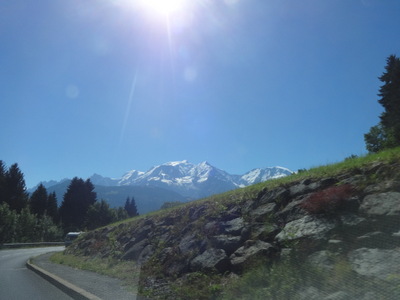
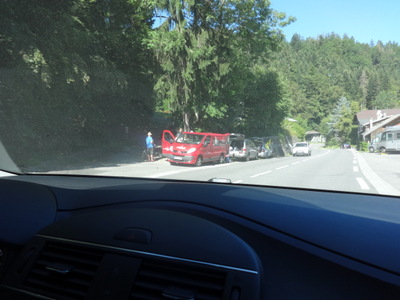 They must watch each stage, then leapfrog ahead to another stage a few days later and take up station for that. And every hotel in the Megève must be filling up with people who just planned to stand by the route to watch the peleton go by, rather than actually living by the roadside, and then to retire to the town's restaurants in the evening.
They must watch each stage, then leapfrog ahead to another stage a few days later and take up station for that. And every hotel in the Megève must be filling up with people who just planned to stand by the route to watch the peleton go by, rather than actually living by the roadside, and then to retire to the town's restaurants in the evening.
The warning signs listed two stages of the tour, so perhaps one stage ended in Megève and the next started there.
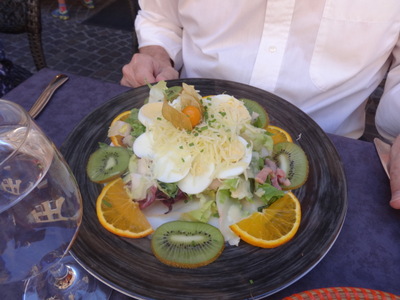
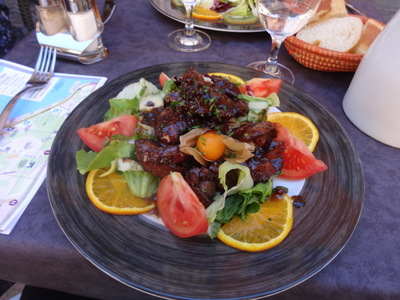 Because I was able to phone ahead and ask directions to the hotel's parking garage (travel is so much easier with a cell phone), we found the place easily, checked in, and had time to go looking for lunch.
Because I was able to phone ahead and ask directions to the hotel's parking garage (travel is so much easier with a cell phone), we found the place easily, checked in, and had time to go looking for lunch.
We found a good selection of salads at a place called "La Bigoudine." At the left is David's "peasant" salad, with lardons, cheese, and sliced hard-cooked eggs. At the right is my "Bressanne," heaped with chicken livers dressed with a raspberry balsamic vinaigrette. Both excellent.
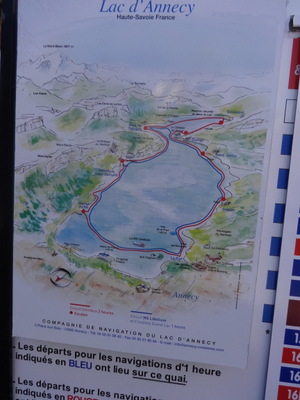
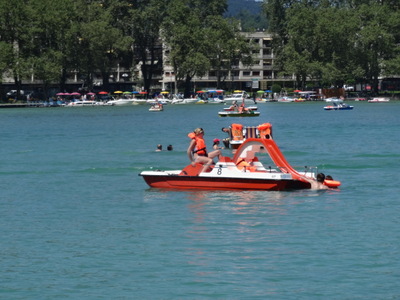 Then the first order of business was to walk the few blocks to the lake to find a boat tour. The same company has boats on both lakes, Le Bourget and Annecy, so we found one easily.
Then the first order of business was to walk the few blocks to the lake to find a boat tour. The same company has boats on both lakes, Le Bourget and Annecy, so we found one easily.
Like the Lac du Bourget, the Lac d'Annecy is long and narrow and its axis runs north-south. This map shows a rather foreshortened version, viewed from the north looking southward. The blue line is the route of our 1-hour tour, which proceeded clockwise around the lake.
The lake is drained (northward) by the Fier River and several canals. The tour boats were docked in one of those canals, which opens into the main pleasure harbor (only one professional fisherman works the lake, so almost all the boats are pleasurecraft). As at the other lake, the company has several sizes of boats, including one set up for dinner cruises.
You can rent all sorts of small boats, including these little two-person peddle boats, some of which, like this one, had slides mounted on them. As on all French bodies of water, a common sight was little one-person sailboats used to teach beginners to sail—you always see a power boat or two towing lines of them back to harbor after the lesson.
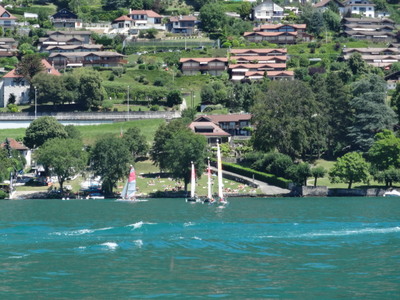
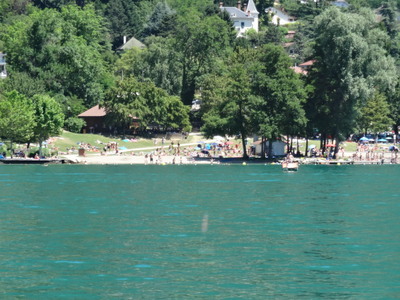 This lake has no "wild coast"; tourism continues pretty much all around the edge. Here at the left is a grass "beach" for those who prefer to spread their blankets on a lawn with shade trees. In front of it, a line of little sail boats set out for a lesson.
This lake has no "wild coast"; tourism continues pretty much all around the edge. Here at the left is a grass "beach" for those who prefer to spread their blankets on a lawn with shade trees. In front of it, a line of little sail boats set out for a lesson.
At the right is a traditional "sand" beach; I suspect the sand had to be imported for the purpose. We passed several of each kind of beach on our tour.
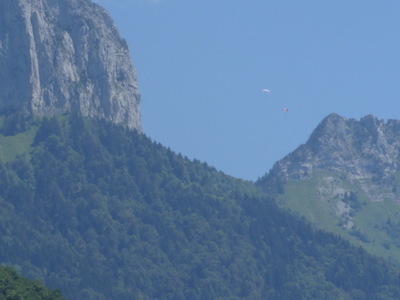
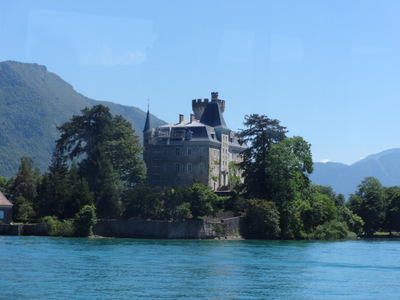 The photo at the left was intended to show white hang glider just above and to the right of center, but even with telephoto, it's just a white dot. The skies were dotted with them all up and down the western coast of the lake—we could see them perfectly well with the naked eye, but I didn't succeed in getting very good photos. They all seemed to be of the rectangular parachute type; I didn't see any of the delta-wing sort.
The photo at the left was intended to show white hang glider just above and to the right of center, but even with telephoto, it's just a white dot. The skies were dotted with them all up and down the western coast of the lake—we could see them perfectly well with the naked eye, but I didn't succeed in getting very good photos. They all seemed to be of the rectangular parachute type; I didn't see any of the delta-wing sort.
Several castle-like structure were visible around the lake. I think this is the one that the guide said was still a private residence. Others are hotels or have been put to other uses.
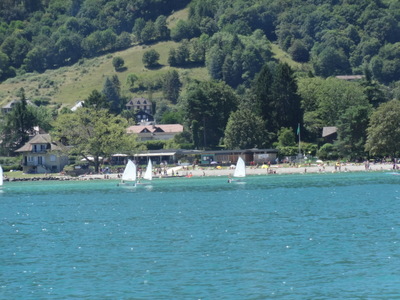
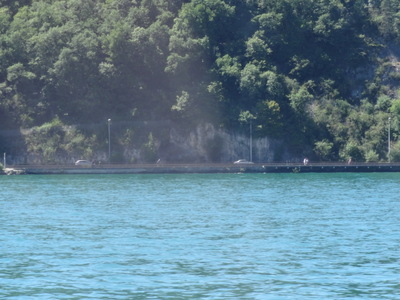 Here's another sand beach, again partially screened by a flotilla of training sailboats.
Here's another sand beach, again partially screened by a flotilla of training sailboats.
At the right is a section of shore where the cliff drops straight down into the water. The road builders' solution was to sink pilings and build the road out over the water so that it could continue all the way around the lake. I didn't see much in the way of nature study around Annecy (although admittedly we were only there for a day); it's a much more popular tourist destination than Le Bourget, although few of the tourists are Americans or even Brits.
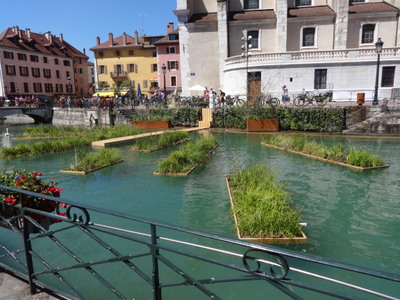
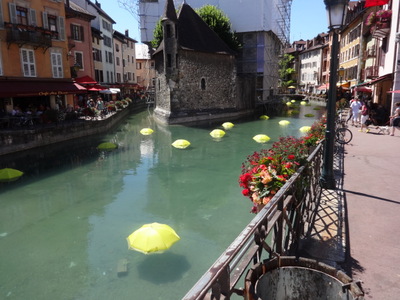 After our cruise, we strolled back along the canals to visit the Office de Tourisme in search of a walking tour for the following morning. Along the way, I was delighted to find these little floating marshes tethered in the canal.
After our cruise, we strolled back along the canals to visit the Office de Tourisme in search of a walking tour for the following morning. Along the way, I was delighted to find these little floating marshes tethered in the canal.
Below the next bridge (and in several other reaches) they were replaced by floating yellow umbrellas. Clearly, the latter must be art, but I hoped that the marshes were permanent. The ducks and swans were making use of them.
The pointed stone structure where the two branches of the canal meet was all we got to see of the Palais de l'Îsle, an iconic historical building, a museum since the 1950's, that's currently closed for renovations and shrouded in scaffolding and canvas. Like most ancient stone buildings in France it has been a religious institution, a military one, and a prison at various times. The last prisoners held there (after a gap, when it was put to other uses) were Germans, during WWII. Occasionally one of them comes back to see it as a tourist.
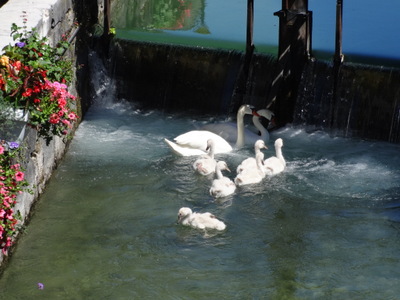
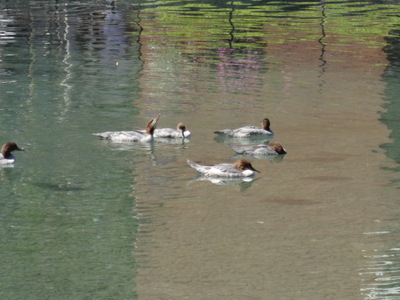 The meandering and branching canals have given Annecy the nickname "Venice of the Alps," and they do add greatly to the town's picturesquity quotient.
The meandering and branching canals have given Annecy the nickname "Venice of the Alps," and they do add greatly to the town's picturesquity quotient.
This family of swans was foraging below one of the small wiers that control the water levels in the canals, and at the right is a flock of common mergansers doing the same in a calmer area. You can tell by their long pointed bills that they're fish eaters.
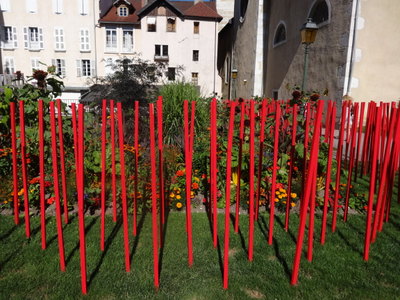
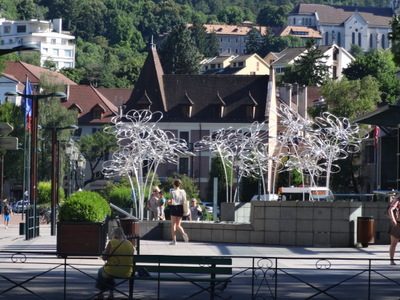 These red stakes were clustered in front of the flower gardens in a town square, and the sort of egg-whisk structures decorated the space in front of city hall. Art, clearly.
These red stakes were clustered in front of the flower gardens in a town square, and the sort of egg-whisk structures decorated the space in front of city hall. Art, clearly.
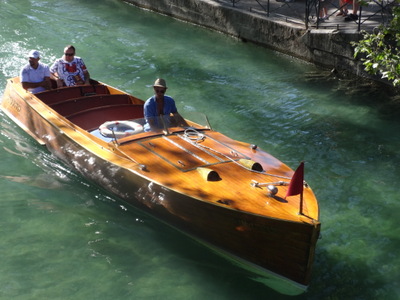
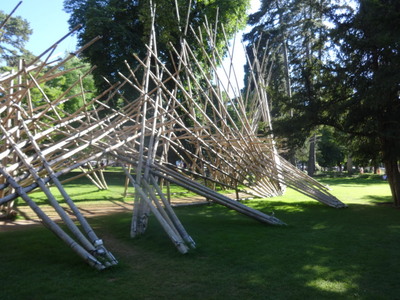 As we strolled along the canals, in addition to such sights as this beautiful wooden boat (which we could probably have hired for a tour; we saw a couple of them out on the lake as well), we were treated to amazing sights like diving grebes! Great crested grebes, the first I've ever actually seen in the wild, foraging in the can.als, heedless of tourists and boat traffic, and because the water so shallow and very clear, we could actually see them zooming around under water in pursuit of fish! They're really fast; they fold their wings and propel themselves with their feet. Amazing sight.
As we strolled along the canals, in addition to such sights as this beautiful wooden boat (which we could probably have hired for a tour; we saw a couple of them out on the lake as well), we were treated to amazing sights like diving grebes! Great crested grebes, the first I've ever actually seen in the wild, foraging in the can.als, heedless of tourists and boat traffic, and because the water so shallow and very clear, we could actually see them zooming around under water in pursuit of fish! They're really fast; they fold their wings and propel themselves with their feet. Amazing sight.
In a nearby park were a couple of these structures, which you could actually walk around and through. Also clearly art.
Equipped with the walking tour schedule, we retired to our hotel to rest up for dinner, which was at l'Esquisse ("The Sketch").
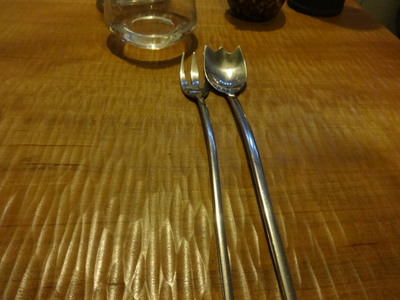
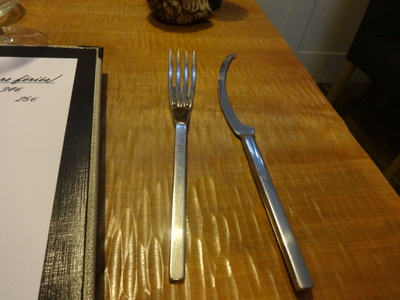 At the restaurant, we were immediately struck by the lean and hungry look of the silverware. The knife and dinner fork look positively rapacious!
At the restaurant, we were immediately struck by the lean and hungry look of the silverware. The knife and dinner fork look positively rapacious!
Perhaps they account for the rather gnawed look of the table surface.
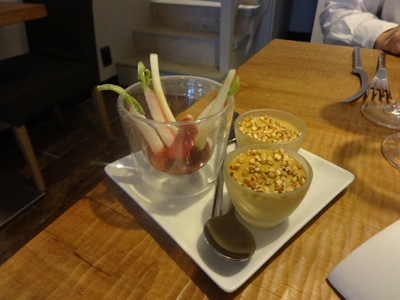
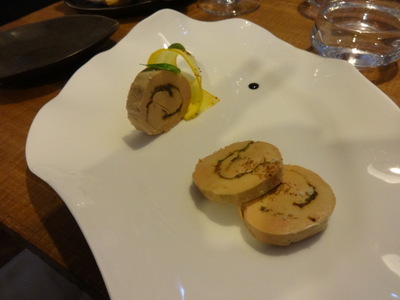 The amuse-bouche consisted of two parts: a glass with a red purée (beets?) in the bottom and small fresh crudités to dip in it, and cups of a cream of shallot with toasted seeds (shallot seeds?) on top. As you can see, we were given normal, healthy-looking spoons to eat it with. They also put a few organic green olives on the table.
The amuse-bouche consisted of two parts: a glass with a red purée (beets?) in the bottom and small fresh crudités to dip in it, and cups of a cream of shallot with toasted seeds (shallot seeds?) on top. As you can see, we were given normal, healthy-looking spoons to eat it with. They also put a few organic green olives on the table.
We chose the menu option that included three courses, cheese, and dessert. The first course was salt-cooked foie gras, rolled with tomato and basil. Good, but not, it seemed to me, an improvement over plain foie gras. The yellow decoration is a very thin lengthwise slice of golden zucchini.
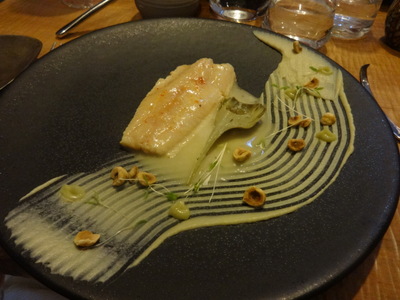
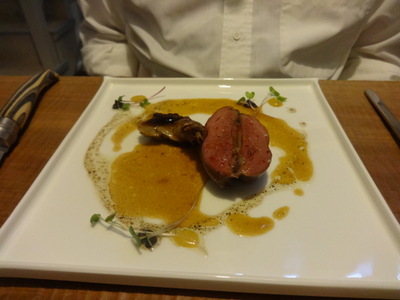 Next came fish promised to come either from the aquatic farm of a named supplier on the Isère or to be wild caught by another in Lake Léman (i.e. Lake Geneva). I forgotted which we got and even which fish it was (whitefish is a good bet), but it was delicious paired with an artichoke heart, artichoke puré, dots of a citrus purée, and toasted hazelnuts.
Next came fish promised to come either from the aquatic farm of a named supplier on the Isère or to be wild caught by another in Lake Léman (i.e. Lake Geneva). I forgotted which we got and even which fish it was (whitefish is a good bet), but it was delicious paired with an artichoke heart, artichoke puré, dots of a citrus purée, and toasted hazelnuts.
We had our choice of meats. David chose the rare breast of pigeon, accompanied by the glazed leg.
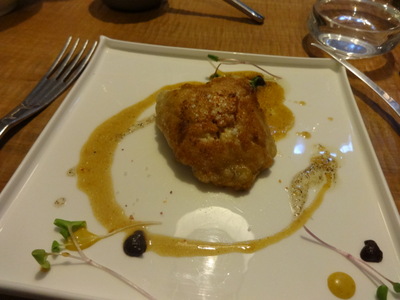
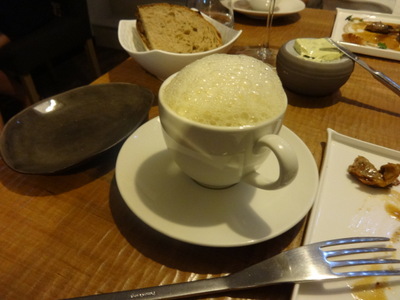 I took the other option, roasted veal sweetbreads, which were excellent.
I took the other option, roasted veal sweetbreads, which were excellent.
With the meat course, we got these foaming teacups, one each, filled with a purée of something delicious and creamy. Potatoes, we think.
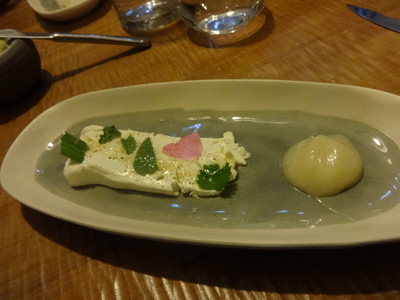
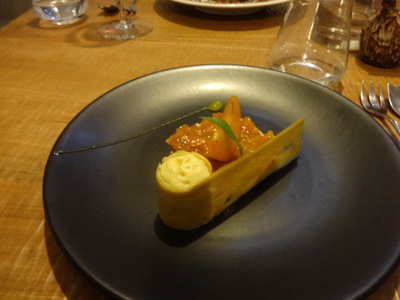 The cheese course was listed as "fromage cuisiné," which doesn't really translate "cooked cheese," but more like "prepared cheese." It turned out to be a slice of cheese (sorry, I've forgot which one) dressed with a little vinaigrette, herbs, and a flower petal, served with a splodge of creamy-textured honey. Tasty.
The cheese course was listed as "fromage cuisiné," which doesn't really translate "cooked cheese," but more like "prepared cheese." It turned out to be a slice of cheese (sorry, I've forgot which one) dressed with a little vinaigrette, herbs, and a flower petal, served with a splodge of creamy-textured honey. Tasty.
The dessert on the menu was listed as "tout choc'" (all chocolate, but just in case of allergies and aversions, they offered a fruit option as well, which I chose. A tuile cookie had been baked as a long rectangular strip, one end of which was curled into a circle while it was still hot and soft. They filled that circle with a pastry cream flavored with lemon verbena and served it with a fresh apricot marmalade and slice of fresh apricot. Yum.
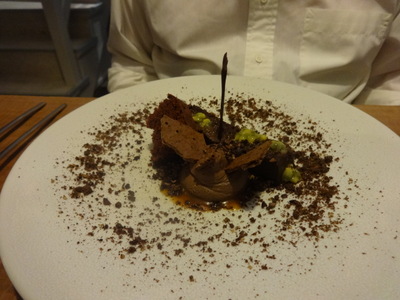 David went for the full chocolate Monte and got this sort of chocolate train wreck—a splodge of chocolate ganache into which were stuck shards of brownie crisp, a rectangle of dark chocolate cake, and a spire of pure chocolate and sprinkled all over with cocoa. Just to cut the richness a little, they added a few yellowish-green passion-fruit seeds to the mix. David pronounced it delicious.
David went for the full chocolate Monte and got this sort of chocolate train wreck—a splodge of chocolate ganache into which were stuck shards of brownie crisp, a rectangle of dark chocolate cake, and a spire of pure chocolate and sprinkled all over with cocoa. Just to cut the richness a little, they added a few yellowish-green passion-fruit seeds to the mix. David pronounced it delicious.
The mignardises consisted of chocolate cornflake clusters, fresh currants, and fresh Jerusalem cherries (Physalis berries). I include no photo because I accidentally caught our credit card in the image—not a good thing to post on the internet!
Previous entry
List of Entries
Next entry

 Breakfast at Coeur de Megève was pretty good (as well it might have been, given what the place charges). At the left here is the assortment of breads and pastries, and behind that are the egg boiler, basket of eggs, and collection fo salt and pepper shakers.
Breakfast at Coeur de Megève was pretty good (as well it might have been, given what the place charges). At the left here is the assortment of breads and pastries, and behind that are the egg boiler, basket of eggs, and collection fo salt and pepper shakers.
 The drive back down the mountain to the freeway was still picturesque, in that the forests and mountains still formed a beautiful backdrop, but preparations for the impending Tour de France were beginning to litter the landscape. People in campers, vans, and Winebago-style camping cars were setting up camp along the route, getting out charcoal grills, picnicking on their tailgates, and hanging out laundry. The roads were also full of bicyclists, kitted out for racing. I assume they were just enthusiasts following the tour, but maybe they were scouts for the various teams, checking out the terrain in advance.
The drive back down the mountain to the freeway was still picturesque, in that the forests and mountains still formed a beautiful backdrop, but preparations for the impending Tour de France were beginning to litter the landscape. People in campers, vans, and Winebago-style camping cars were setting up camp along the route, getting out charcoal grills, picnicking on their tailgates, and hanging out laundry. The roads were also full of bicyclists, kitted out for racing. I assume they were just enthusiasts following the tour, but maybe they were scouts for the various teams, checking out the terrain in advance. 
 They must watch each stage, then leapfrog ahead to another stage a few days later and take up station for that. And every hotel in the Megève must be filling up with people who just planned to stand by the route to watch the peleton go by, rather than actually living by the roadside, and then to retire to the town's restaurants in the evening.
They must watch each stage, then leapfrog ahead to another stage a few days later and take up station for that. And every hotel in the Megève must be filling up with people who just planned to stand by the route to watch the peleton go by, rather than actually living by the roadside, and then to retire to the town's restaurants in the evening. 
 Because I was able to phone ahead and ask directions to the hotel's parking garage (travel is so much easier with a cell phone), we found the place easily, checked in, and had time to go looking for lunch.
Because I was able to phone ahead and ask directions to the hotel's parking garage (travel is so much easier with a cell phone), we found the place easily, checked in, and had time to go looking for lunch.
 Then the first order of business was to walk the few blocks to the lake to find a boat tour. The same company has boats on both lakes, Le Bourget and Annecy, so we found one easily.
Then the first order of business was to walk the few blocks to the lake to find a boat tour. The same company has boats on both lakes, Le Bourget and Annecy, so we found one easily.
 This lake has no "wild coast"; tourism continues pretty much all around the edge. Here at the left is a grass "beach" for those who prefer to spread their blankets on a lawn with shade trees. In front of it, a line of little sail boats set out for a lesson.
This lake has no "wild coast"; tourism continues pretty much all around the edge. Here at the left is a grass "beach" for those who prefer to spread their blankets on a lawn with shade trees. In front of it, a line of little sail boats set out for a lesson.
 The photo at the left was intended to show white hang glider just above and to the right of center, but even with telephoto, it's just a white dot. The skies were dotted with them all up and down the western coast of the lake—we could see them perfectly well with the naked eye, but I didn't succeed in getting very good photos. They all seemed to be of the rectangular parachute type; I didn't see any of the delta-wing sort.
The photo at the left was intended to show white hang glider just above and to the right of center, but even with telephoto, it's just a white dot. The skies were dotted with them all up and down the western coast of the lake—we could see them perfectly well with the naked eye, but I didn't succeed in getting very good photos. They all seemed to be of the rectangular parachute type; I didn't see any of the delta-wing sort.
 Here's another sand beach, again partially screened by a flotilla of training sailboats.
Here's another sand beach, again partially screened by a flotilla of training sailboats. 
 After our cruise, we strolled back along the canals to visit the Office de Tourisme in search of a walking tour for the following morning. Along the way, I was delighted to find these little floating marshes tethered in the canal.
After our cruise, we strolled back along the canals to visit the Office de Tourisme in search of a walking tour for the following morning. Along the way, I was delighted to find these little floating marshes tethered in the canal.
 The meandering and branching canals have given Annecy the nickname "Venice of the Alps," and they do add greatly to the town's picturesquity quotient.
The meandering and branching canals have given Annecy the nickname "Venice of the Alps," and they do add greatly to the town's picturesquity quotient.
 These red stakes were clustered in front of the flower gardens in a town square, and the sort of egg-whisk structures decorated the space in front of city hall. Art, clearly.
These red stakes were clustered in front of the flower gardens in a town square, and the sort of egg-whisk structures decorated the space in front of city hall. Art, clearly.
 As we strolled along the canals, in addition to such sights as this beautiful wooden boat (which we could probably have hired for a tour; we saw a couple of them out on the lake as well), we were treated to amazing sights like diving grebes! Great crested grebes, the first I've ever actually seen in the wild, foraging in the can.als, heedless of tourists and boat traffic, and because the water so shallow and very clear, we could actually see them zooming around under water in pursuit of fish! They're really fast; they fold their wings and propel themselves with their feet. Amazing sight.
As we strolled along the canals, in addition to such sights as this beautiful wooden boat (which we could probably have hired for a tour; we saw a couple of them out on the lake as well), we were treated to amazing sights like diving grebes! Great crested grebes, the first I've ever actually seen in the wild, foraging in the can.als, heedless of tourists and boat traffic, and because the water so shallow and very clear, we could actually see them zooming around under water in pursuit of fish! They're really fast; they fold their wings and propel themselves with their feet. Amazing sight.
 At the restaurant, we were immediately struck by the lean and hungry look of the silverware. The knife and dinner fork look positively rapacious!
At the restaurant, we were immediately struck by the lean and hungry look of the silverware. The knife and dinner fork look positively rapacious!
 The amuse-bouche consisted of two parts: a glass with a red purée (beets?) in the bottom and small fresh crudités to dip in it, and cups of a cream of shallot with toasted seeds (shallot seeds?) on top. As you can see, we were given normal, healthy-looking spoons to eat it with. They also put a few organic green olives on the table.
The amuse-bouche consisted of two parts: a glass with a red purée (beets?) in the bottom and small fresh crudités to dip in it, and cups of a cream of shallot with toasted seeds (shallot seeds?) on top. As you can see, we were given normal, healthy-looking spoons to eat it with. They also put a few organic green olives on the table.
 Next came fish promised to come either from the aquatic farm of a named supplier on the Isère or to be wild caught by another in Lake Léman (i.e. Lake Geneva). I forgotted which we got and even which fish it was (whitefish is a good bet), but it was delicious paired with an artichoke heart, artichoke puré, dots of a citrus purée, and toasted hazelnuts.
Next came fish promised to come either from the aquatic farm of a named supplier on the Isère or to be wild caught by another in Lake Léman (i.e. Lake Geneva). I forgotted which we got and even which fish it was (whitefish is a good bet), but it was delicious paired with an artichoke heart, artichoke puré, dots of a citrus purée, and toasted hazelnuts.
 I took the other option, roasted veal sweetbreads, which were excellent.
I took the other option, roasted veal sweetbreads, which were excellent.
 The cheese course was listed as "fromage cuisiné," which doesn't really translate "cooked cheese," but more like "prepared cheese." It turned out to be a slice of cheese (sorry, I've forgot which one) dressed with a little vinaigrette, herbs, and a flower petal, served with a splodge of creamy-textured honey. Tasty.
The cheese course was listed as "fromage cuisiné," which doesn't really translate "cooked cheese," but more like "prepared cheese." It turned out to be a slice of cheese (sorry, I've forgot which one) dressed with a little vinaigrette, herbs, and a flower petal, served with a splodge of creamy-textured honey. Tasty. David went for the full chocolate Monte and got this sort of chocolate train wreck—a splodge of chocolate ganache into which were stuck shards of brownie crisp, a rectangle of dark chocolate cake, and a spire of pure chocolate and sprinkled all over with cocoa. Just to cut the richness a little, they added a few yellowish-green passion-fruit seeds to the mix. David pronounced it delicious.
David went for the full chocolate Monte and got this sort of chocolate train wreck—a splodge of chocolate ganache into which were stuck shards of brownie crisp, a rectangle of dark chocolate cake, and a spire of pure chocolate and sprinkled all over with cocoa. Just to cut the richness a little, they added a few yellowish-green passion-fruit seeds to the mix. David pronounced it delicious.